Hasivo S600WP-4GT-1SX-1XGT-SE Management
This is a web-managed switch. We can go to 192.168.0.1 and login. The default username and password was admin/ admin.
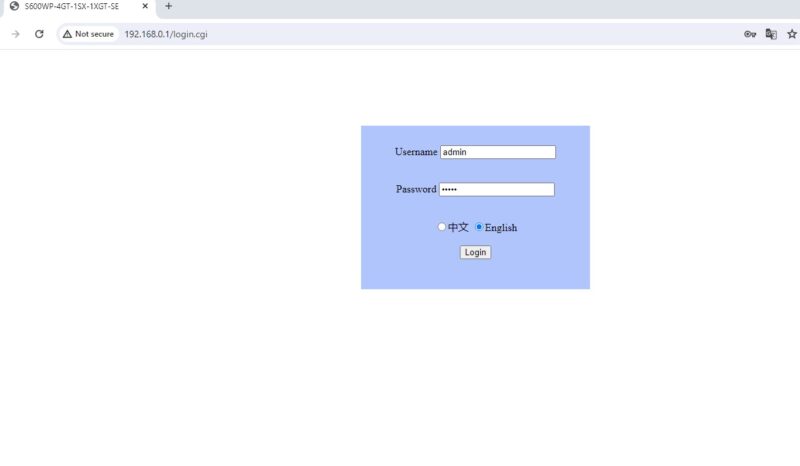
Something that is a bit of a challenge with this is that 192.168.0.1 is the default IP for the gateway on many SMB/ home routers. It would be nice if this was something else to limit the chance for a conflict to arise. For most, the setup process is set a NIC to 192.168.0.2 and a subnet mask of 255.255.255.0 and then point the browser to 192.168.0.1.
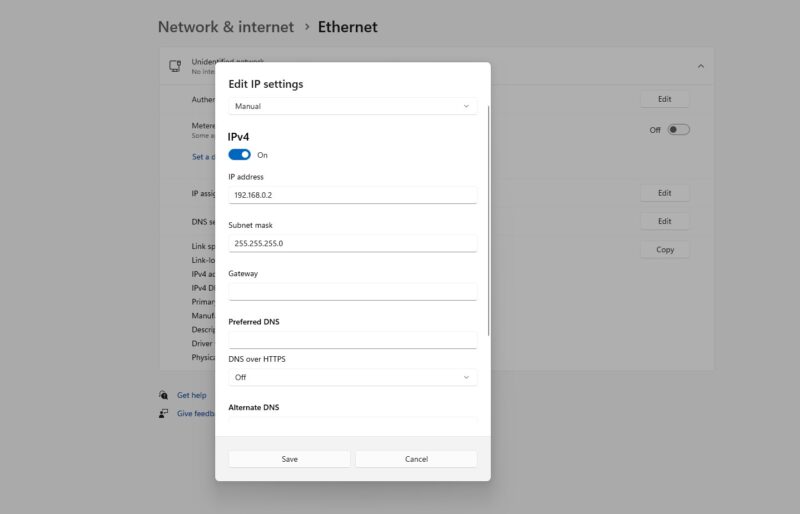
One other challenge we should mention, and this was first found by someone on AliExpress, is that it seems these were manufactured with a common MAC address. Hopefully this is fixed by now (we received ours in Q4 2023.) Still, if you have a big L2 network and put two of these switches on it, you can run into issues of having a duplicate MAC if it is not fixed.
While this is not the most exciting management interface, looking like a web page from the late 1990s, there are a few nice features. Take, for instance, the top port status display. We can see we are plugged into port 1 here.
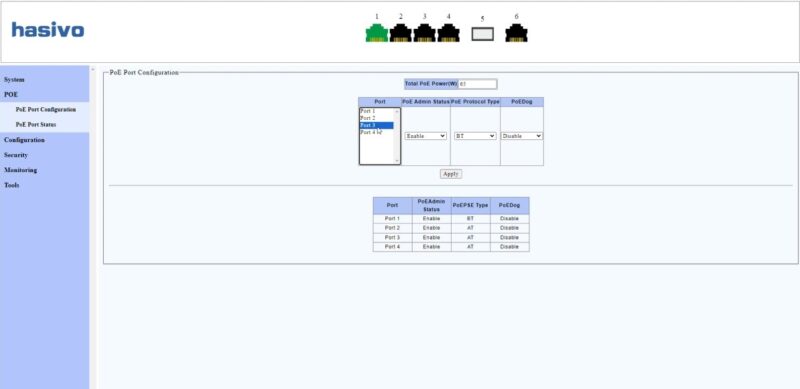
Since this is the S600WP, we can see our Port 1 802.3bt and Ports 2-4 802.3at. We are going to talk most about the actual power delivery capacity in the power section.
The VLAN configuration worked, but it is a bit clunky.
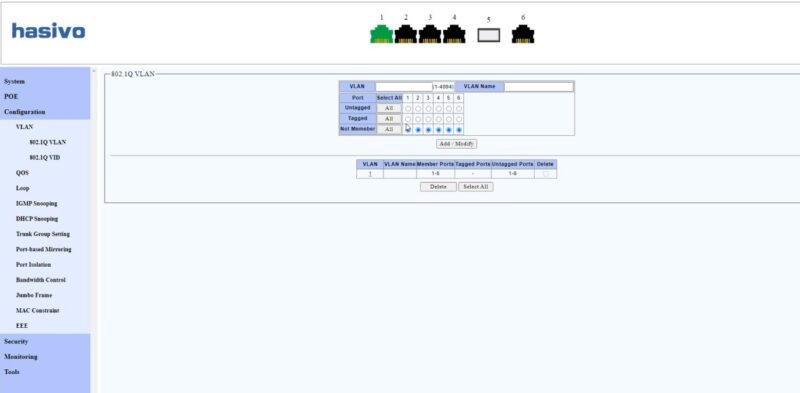
There are several spanning tree port settings:
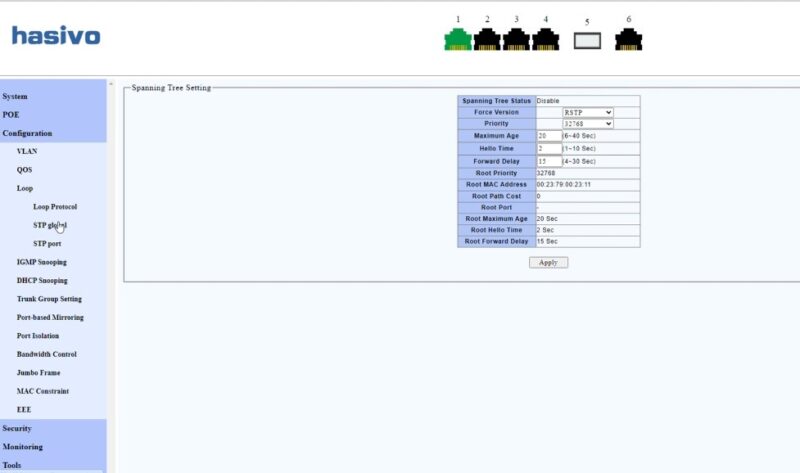
Overall, there is a lot here, but it is still a low power web managed smart switch. If you are thinking that this switch is going to be a replacement for a high-end Cisco device, it is better to temper those expectations. This is a fairly simple web management interface. If you just want basic web management to setup VLANs for example, then this is going to be a huge feature that puts this switch in a different class from the unmanaged switches we have reviewed.
The other side to the management is, of course, that there is a switch on the front faceplate to turn this off. Many will either want an unmanaged switch today, and possibly have management in the future, or the opposite, so this provides a bit more flexibility.
Hasivo S600WP-4GT-1SX-1XGT-SE Performance
In terms of performance, this seems to be a decent performer. We tried these switches both in unmanaged:
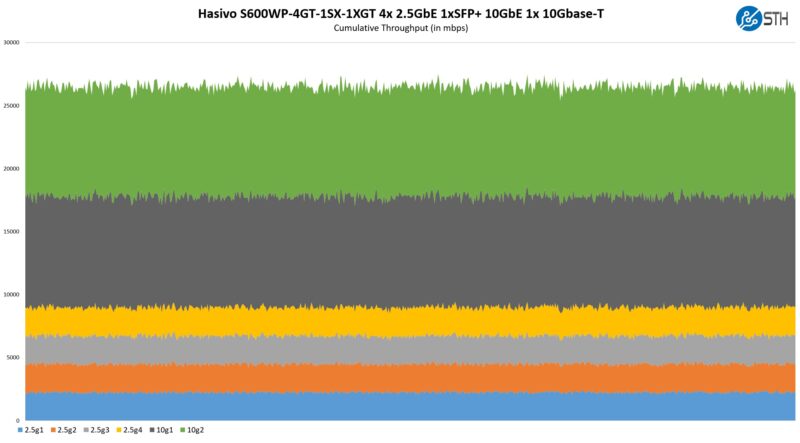
As well as managed mode with a flat L2 network just to see if there would be an appreciable change:
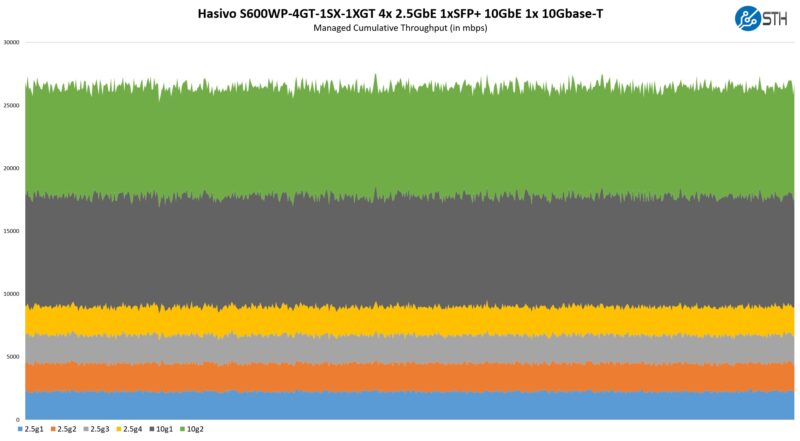
To us, that is very similar performance. This switch performed similarly to the other inexpensive switches we have reviewed based on the Realtek RTL8372.
Hasivo S600WP-4GT-1SX-1XGT-SE Power Consumption
This Hasivo comes with a small 52V 1.25A power adapter. That is important since it limits us to around 65W of total power output for the switch, and for PoE.
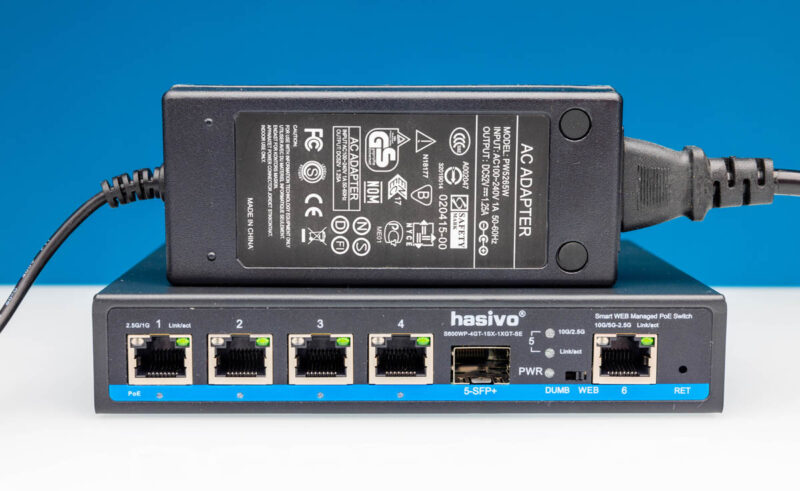
Like most PoE versions of switches, this one idles slightly higher at 2.3W. That is about 1W more than the non-PoE version.
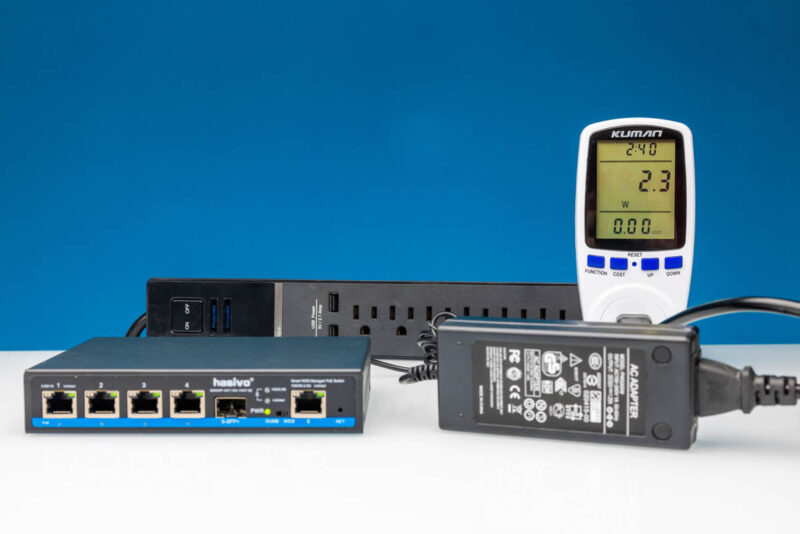
With a single 2.5GbE port plugged in, we added 1W for 3.3W total. Incrementally, that is in-line with other low-cost switches.
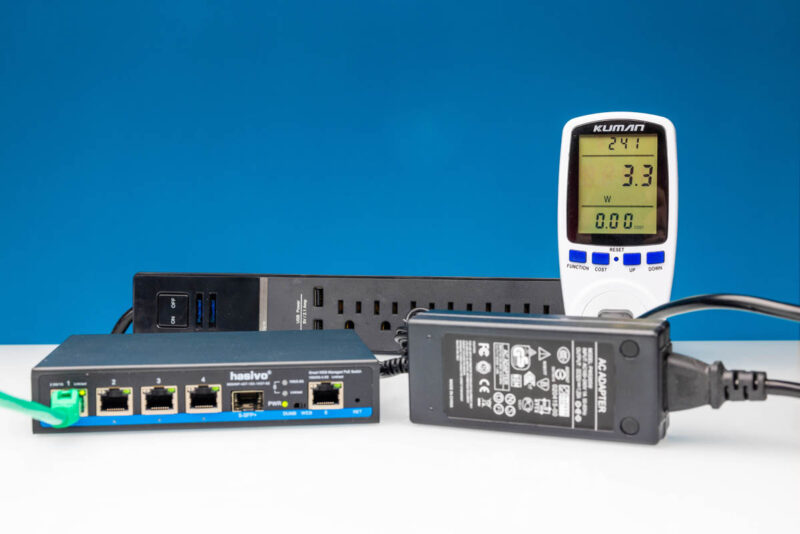
We used a 10Gbase-T SFP+ pluggable to add a good amount of power consumption in a SFP+ port and we got 4W. An incremental 1.7W is actually good, and better than some other switches we have seen with this pluggable.
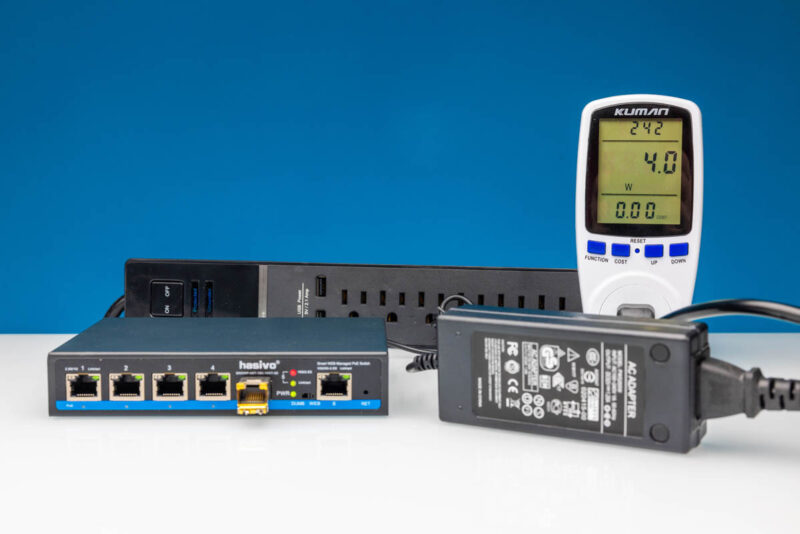
Finally, we lit the port at 10Gbase-T speeds, and saw 5.3W. That is a whopping 3W higher than the switch before we plugged in the port. When we say 10Gbase-T uses a lot of power, this is a great example.
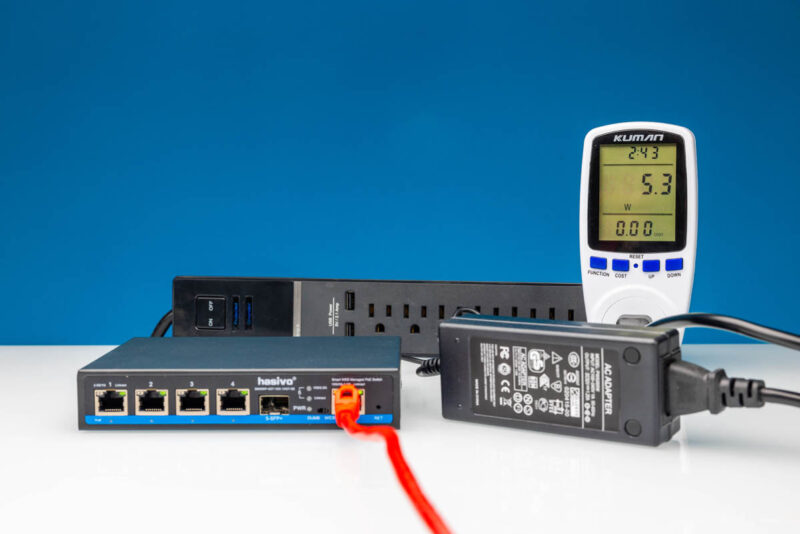
Overall, this switch used a bit more power due to being PoE and having 10Gbase-T. At the same time, the switch itself can use around 10-15W with everything plugged-in. With a 65W power supply, that leaves only around 50W for PoE devices, and there is usually a decent amount of power loss going over PoE. For a low-cost switch like this, that is OK. If you want to run some big 90W PoE++ device, this is not going to handle that kind of power.
Final Words
We have had a lot of folks ask for inexpensive managed switches. Some prefer unmanaged. We also have folks ask for PoE switches. Others still prefer either SFP+ or 10Gbase-T. The crazy part about this switch is that at $119, it fills all of those needs.
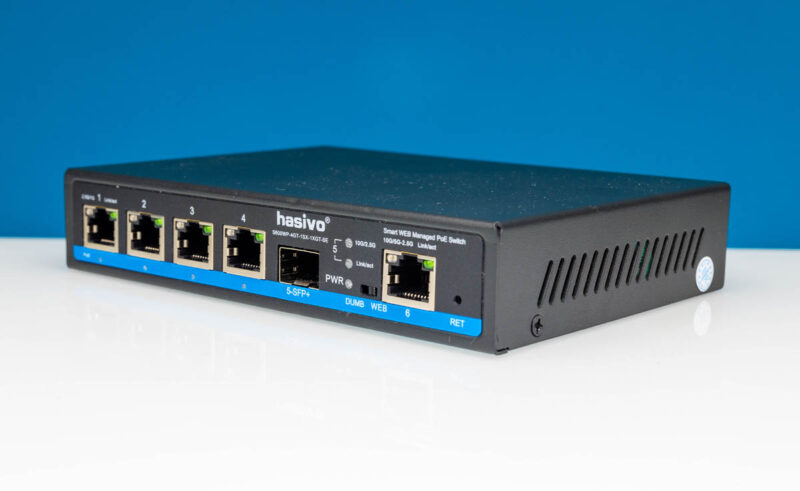
That $119 is nowhere near the cheapest, but the SFP+ to 10Gbase-T adapters out these days are now around $50-70. We just had a case where we were trying to attach the Minisforum MS-01 with its SFP+ ports to a QNAP TBS-574TX E1.S Thunderbolt 4 10GbE NAS that has 10Gbase-T. In that moment, this arrangement made perfect sense. Add to that the extra 4-port 2.5GbE 802.3at and single bt port and there is a lot of flexibility. If you have a small office, an apartment, or for some, just a room that you want to connect, this can be a really neat option.
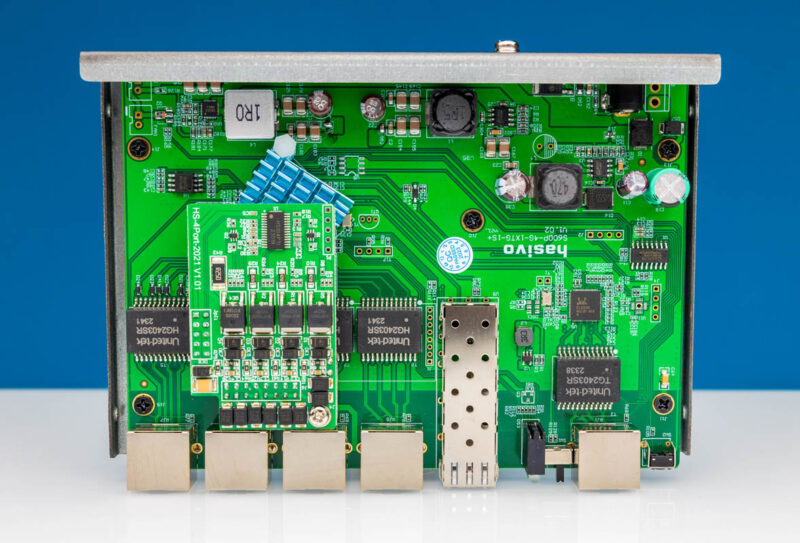
While this is not perfect, it is hard to not take a step back and realize that this has every feature one could want in a small fanless chassis.
Where to Buy
We purchased our unit on AliExpress. Here is the affiliate link for this model.
Note: For those that prefer Amazon, here is an affiliate link to the MokerLink unit which we are told is the same.
Ultimate Fanless 2.5GbE Switch Buyer’s Guide
You may have seen that we published the Ultimate Cheap Fanless 2.5GbE Switch Buyer’s Guide. Here is the video for that one:
You can see more switches in this class in that video.




I got the Mokerlink version of this (non-PoE) today from Amazon. Identical PCB (minus the PoE daughterboard), it even has the same Hasivo branding.
I see the PCB has been designed to support dual DC inputs, although sadly not populated.
Thanks for the testing, good to see that it should perform well when I get it installed!
Yall might want to take a look at the Terow 2.5gbe unmanaged switch. B0CGDCBBV3 . I picked one up to power a 2.5gbe wifi7 AP (Ubiquiti U7Pro). Has 2 10gig sfps, and 4 2.5gbe poe ports. Max Poe Budget is also 65w like this switch you reviewed. The main thing going for it is after the current promos it’s only about $50. Amazon has a 10% and 20% promo on it that stacks. Great deal for the few devices you have that need 2.5gbe.
Key question you seem to never answer for those switches – can you limit the web interface to a single vlan, or is it always accessible from any port any vlan.
Would be interesting if people could test if there is a hidden menu at /system_set.html where the MAC can be changed. If not, a copy of the firmware would be interesting.
Patrick et all; do you have suggestions for compatible cheap transceivers for the SFP+ cage on these cheap Chinese switches?
@Arneby: I’m using Ipolex 10GBASE-SX fiber transceivers with my other Hasivo switch and they work fine. They are manufactured by 10Gtek so those would likely also work.
In general, I don’t expect these switches to be very picky except possibly with DACs. Hasivo doesn’t do any vendor locking as far as I’m aware.
Nice little switch. There is one thing I could not see anywhere: does it support SNMP ?
@Blunden I’m looking to put a Unifi Flex XG (5p 10GbE switch) in the rack and one of these switches in several places creating 2.5GbE ‘islands’ with 10GbE uplinks. I have Cat 6A run all over so I need something with RJ45 interface. Would that still be Ipolex or 10Gtek?
@all
Are there any downsides to using such a non Ubiquiti switch within a Unifi system including Docker controller and Ubiquiti access points? Is one better off using Ubiquiti switches in such a system?
@sylaan: No. Apparently not. I think I saw it in the YouTube comments.
@Arneby: As long as your run is less than 30 meters, I’m guessing most of the 10GBASE-T transceivers will work. Just know that those kind of transceivers can generate quite a bit of heat. :)
@Joseph Kevin: It will make configuring things such as VLANs (and other settings that would normally be propagated to the switch) slightly more cumbersome and your Unifi controller obviously won’t be aware of it and may therefore make the topology look a bit weird. It should still work fine though, so it’s really up to you how integrated you want things to be.
@blunden: Both /system_set.html and /oem_set.html return a 404 (tested while logged in). From what I can see all the configuration URLs seem to end in .cgi (but /system_set.cgi also doesn’t work).
There also appears to be no obvious way to dump the firmware. The ‘Tools’ menu offers a Firmware Upgrade option which appears to put the switch into a different mode — entering this mode causes the web interface to only offer an option to provide a firmware file to upgrade, or reboot the switch. There’s no way back to the ‘normal’ management interface without rebooting the switch (either via the web UI or physically). I can’t find any other firmware-related options.
The firmware version installed is V1.8, dated Nov 23 2023.
@Alexis: Ok, thanks for testing that. It seems like it’s an entirely different web management implementation then, not just a reskinned version of the old one.
The old model had an option to backup the current firmware images so that’s what I used to dump mine. Here it sounds like we might have to wait for someone to get a firmware update from Hasivo or the other sellers before we have something to pull apart and look for any hidden menus or features.
Btw. does it offer IPv6 support in the UI? On the old model they commented those parts out (but left them in the CLI). Also, does this model have a CLI or just web management?
@blunden: No sign of IPv6 support in the UI. Also no sign of any CLI options, and I ran a full port scan and it only listens on port 80.
It should be possible to get a firmware upgrade from Hasivo I’d expect, the STH video shows their Hasivo switch running firmware V1.6 with a date of Oct 17 2023, whereas my MokerLink branded version is running V1.8 with a date of Nov 23 2023.
For anyone interested regarding the question of re-used MAC addresses, I also confirmed that the MAC address on my MokerLink version is not the same as that pictured in the video for the Hasivo version, although it’s very close — identical first five octets, and a difference of decimal 28 in the last octet.
@Alexis: Ok, that’s too bad. The management UI on the switch I have is certainly more feature rich then.
Yeah, people should be able to contact support to get the latest firmware. I’ve done that in the past. In the YouTube comments, someone mentioned that firmware 1.8 is apparently the version that fixes the MAC adress issue.
I did a bit more poking around, and with the help of this GitHub repo[1], found that you can access the factory configuration menus at /menu_ft.cgi
These do appear to allow you to change the MAC address, if required, as well as allowing you to alter the values for Device Model, Hardware Version, IP, Netmask, Gateway, WEB Site URL (maybe a support site, currently ‘#’), Language (English or Chinese), Default Username, Default Password, Default BT Number (?, currently ‘1’), and Default Power Bank(Walt) [sic] (currently 65).
There’s also options to customise the logo and colours. You can access these pages with the default login credentials.
It’s possible that the details in the GitHub repo for adding a serial console header and accessing it are also valid for this switch, but I haven’t tried it (and likely won’t unless something breaks, it does everything I need)
[1] https://github.com/up-n-atom/SWTG118AS/
I picked up the MokerLink version from Amazon, and it came with v1.6 fw on it. Tried to upgrade to v1.9, but the web interface stops responding when it should go into upgrade mode and never lets me upload the new firmware. Anyone stumble across this before?
Bought the S600W based on this review, i’m not sure where I can find the Link Aggregation setup, but it seems there is none on this switch.
Can you enlighten me where you found this feature?
@Alexis: Great!
I would’ve been surprised if those kind of hidden menus didn’t exist on these as I have a feeling that some manufacturers actually use those during initial customization at the very least.
@Arneby I’d consider going with the aggregate switch over the flex. The ethernet sfps are more expensive, however you can use DAC instead. 10gbe ethernet runs hot and should be avoided whether possible. A 10gbe dac to a unmanged 2.5gbe switch that had a 10gbe sfp port would be best, unless you wanted to run fiber sfps. The aggregation switch is cheaper depending on how many ports you actively need to use. I use a total of 4 (all with DACs). 1 to the udm pro, one to my nic, one to my Nas, one to the 2.5gbe switch.
I purchased the MokerLink version and I’m trying to figure out the SFP+ LED port status lights. Right now, I have a green 2.5G/1G light and a red 10G/5G light. I’m not sure if that means I am connected at 5 or 10G. Does anyone here have any experience with this switch? Its faceplate is a little different than the Hasivo version (the labels differ, but the lights and switches are in the same places).
Thanks!
(the aggregation reply was actually for @Slash, sorry)
@Greg: Doesn’t it tell you the link speed in the management interface?
Is this switch have SNMP feature ?
@Ludo.: Not according to the YouTube comments, no. At least not at this point in time.
I just got one with the V1.9 firmware dated Feb 02 2024.
I’m unable to change the static ip address, and switching it to dhcp assignment *does* work right up until you reboot it -_-.
Can anyone confirm if settings actually stick after a power cycle? it’s almost like it factory resets every power cycle with this firmware version.
@Haddon these are switches that save more like enterprise switches so it’s a 2 step process. I don’t have this one, but I have one of the other Hasivo ones. You saved the running config, but then you need to do the second step of writing that config so that it comes up right on the next boot. That’s common in enterprise and dc switches since if you screw something up, you want it to boot with a known-good config
@M. I ran into this exact same problem on my Amazon mokerlink, and mine came with 1.6. Have you found a solution?
I just received mine with version 1.9, and I did use /menu_ft.cgi to change the default MAC, user/pass, and disabled Chinese language. The MAC change worked only after I rebooted the switch.
I’m pleased as punch, and I think I’ll order another one now that the MAC issue is resolved. Thanks @Alexsis
What brand of 10Gbase-T SFP+ pluggable did you use?
I once purchased a 10/100/1000 Base TX RJ45 2Gbps Fiber Optic Media Converter from fibconet, a supplier from China. The quality was pretty good.